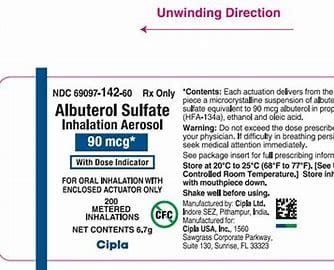What is Albuterol?

Outside the United States, albuterol is a drug used mainly in the form of a salbutamol that regulates and prevents episodes of bronchospasms, or episodes of breathing due to constricted airways. A bronchodilator, albuterol works by relaxing the muscles in the lungs so that air passes through easily and thus improves breathing. Albuterol is primarily used as a medication in the treatment of asthma and chronic obstructive pulmonary disease (COPD). This medication comes in various forms—inhalers, tablets, syrups, and nebulizer solutions.
Formation and Chemical Structure
Albuterol is a short-acting beta-2 adrenergic agonist. Its chemical formula is C13H21NO3. Its molecular makeup enables it to precisely latch onto beta-2 adrenergic receptors in the lungs. The result of such an action will be sympathetic nervous system activation, causing relaxation of muscles around the bronchi while increasing airflow. Such specificity means that it acts effectively on lung tissues while less so on the cardiovascular system.
Mechanism of Action:
It works by exciting the beta-2 adrenergic receptors. These receptors have the effect of causing smooth muscles to relax. This means that when these are excited, it sets a biochemical pathway up that leads the adenosine triphosphate to convert into cyclic adenosine monophosphate, hence, in turn, causing an increase of cAMP. This cAMP increase results in smooth muscles surrounding the airway relaxing, thereby bringing an effect of bronchodilation, and since albuterol widens the airways, it relieves symptoms such as wheezing, coughing, and shortness of breath.
Albuterol usage
Albuterol is used to treat various respiratory conditions, among them:
Asthma:
Albuterol is used as a quick relief medication; especially during attacks, it is prescribed to asthma patients. It is not to be used as a substitute for a controller medication; however, it proves a good quick-relief medication.
COPD:
Relieve breathlessness in patients with conditions included in the syndrome of COPD, a group of lung diseases that make breathing difficult. May prevent and relieve chronic symptoms and during exacerbations.
EIB:
Some patients experience breathlessness during exercise, termed EIB. The preventative use of albuterol 15 to 30 minutes before exercise will treat symptoms.
Dosage and Administration
Albuterol dosage appropriately varies with the patient’s age and medical condition, as well as form of medication.
The recommendations below are general; consult a medical provider for specific advice on use of this medication.
Inhaler:
The usual dosage for adults and children older than 4 years is two inhalations every four to six hours when needed. This medication can also be used for prophylactic treatment before exercise; two inhalations are taken 15-30 minutes beforehand.
Nebulizer Solution:
Nebulized albuterol for hospitalized patients and young children. Dosage for adults: 2.5 mg and for children: 1.25 mg every 4-6 hours.
Tablets and Syrup:
Oral is not generally preferred as it readily induces side effects. Dosage is 2-4 mg every 6-8 hours in adults.
Do not exceed the given dose since higher dosages aggravate the side effects.
Side effects and precautions

Although albuterol is generally a safe drug for most patients, side effects can occur from the treatment. These can be general and include symptoms such as:
Common Side Effects:
Examples of common side effects are generally mild; they include dizziness, headache, palpitations, nervousness, and rapid heart rate. It is often the case that these reactions will subside as the body adjusts to the treatment.
Severe Side Effects:
Although such effects do occur, they are relatively rare and may manifest as chest pain, rapid heartbeats, or worsening of breathing problems. Contact the doctor at once if this occurs.
Allergic Reactions:
A person allergic to albuterol might react to the drug by getting rashes, itches, swelling (specifically facial, tongue, or throat swelling), and problems breathing.
Precautions:
In people with heart conditions, high blood pressure, diabetes, and thyroid conditions, consulting with the doctor is mandatory. Using it regularly can lead to developing unresponsiveness to its usual doses and necessitates increasing additional drugs.
Albuterol can interact with other prescribed and over-the-counter medications; therefore, it is prudent to inform the doctor of the drugs that you may be taking, for example, any supplements. A few of such medications include beta-blockers; these medicines, which treat blood pressure among others, often reduce the ability of albuterol to produce its proper effect on the body. MAO inhibitors, along with tricyclic antidepressants, can strengthen that of albuterol, leading to numerous side effects.
Do not use albuterol with other bronchodilators without consulting your doctor. This may cause serious heart-related side effects.
Storage and Handling
Albuterol inhalers should be kept at room temperature and away from direct heat. Nebulizer solutions, tablets, and syrups should be kept in a cool, dry place out of the reach of direct sunlight. Expiration dates should also be observed since expired albuterol is no longer potent.
Alternatives to Albuterol
Alternatives include using Levalbuterol, the bronchodilator, when the use of albuterol is ineffectual or intolerable, and long-acting beta-agonists:
A treatment, usually used during persistent conditions in which cases like salmeterol or formoterol may be dispensed alongside the prescription of inhaled steroids.
Conclusion

A widely used asthma, COPD, and exercise-induced bronchospasm medication, albuterol loosens up airway muscles and promotes greater airflow. However, its prescription should be followed precisely in the prescribed dosage with or without knowledge of potential side effects. Patients can therefore apply albuterol appropriately in their respiratory management in order to breathe well again and live a more efficient life.



